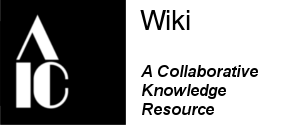Raking light
This page is currently under review.
Would you like to assist? Check out the Contributors' Toolbox to learn how you can help improving the IWG Wiki!
Raking light is an imaging technique that allows recording of the topological features of cultural artifacts. It is frequently used on mostly flat objects, which are illuminated with a light source at a narrow angle with the object’s plane, to create high-contrast shadows and enhance variations of the surface and surface damage that would be concealed with a diffused illumination. Raking light can also reveal recycled canvases by casting shadows from brushstrokes ridges that do not correspond to the subject matter.[1]
Working principle[edit | edit source]
Raking light is an imaging technique where a single light source is positioned at a sharp angle to the object. As a result of the light placement, the surface topography and texture of the subject plane are emphasized through the creation of shadows. This examination technique, used primarily when photographing 2D objects, can amplify the appearance of indentations, undulations, inlays, textile weaves, plate marks, paint cupping, relief objects, and tool marks amongst others. It is particularly useful in documenting the condition and treatment of drawings, paintings, prints, and watercolors. Raking light is also used for highlighting the texture of 3D objects like seals, coins, bas-reliefs, flints and arrowheads.
A general workflow for even illumination captures is available.
The minimal equipment for this experimental setup includes:
- A camera,
- A tripod or a column with a camera mount,
- A prime lens,
- An IR & UV-cut filter to mount on the lens or in front of the sensor,
- Light sources emitting visible light, of which the following are recommended:
- Photoflood with barn doors positioned close together to project a narrow beam,
- Fiber optic,
- Fiber optic lightline with acrylic lens,
- LED lightline,
- Spotlight with focusing condensers and barn doors,
- Open reflector on strobe flash,
- Light stands or other light mounts,
- A target with a sundial-like attachment or gnomon; the gnomon could consist of a nail hit into a board.
Additional recommended tools are:
- A neutral background,
- A bounce card (white foam board, white paper, or white sheet),
- Mounting grips, arms, and clamps may be necessary to hold the target or bounce cards in place,
- A working station to control the session in tethering mode.
General recommendations[edit | edit source]
Illumination in raking light should be done from the top and from the left to avoid perceptual biases, like the inverted perception of depth. Some surface features may run parallelly to the light beam, therefore documenting the object with the light orientation both from the top and from the left is ideal.
The light source should be positioned as far from the object as possible to minimize a drastic light fall-off and produce a more even illumination across the field of view.
The raking light source should be a narrow slit or a point in order to provide the high contrast and definition to the shadows. Light sources that are too diffused will give lower contrast to surface topography.
The scene should ideally include a color target with a gnomon or visual indicator for directional light, so that the light orientation can be replicated for standardized captures.
Marking the position and orientation of the light sources with tape helps the repositioning and standardized captures.
Objects with particularly pronounced ridges or creases tend to cast darker shadows, which may lead to loss of context. Using a bounce card or an additional filling light source can help reduce the contrast without altering the shadows; this can be placed at a wider angle, opposed to the raking source, and set at a low intensity.
Optimal exposure is determined by the ability to distinguish the features of interest, rather than by the target’s values. This is because the light intensity varies across the scene, hence altering the relative brightness of the color patches.
If the camera used for the capture has a low resolution, but a high level of detail is still desired, capturing only the area of interest as close to the object as possible can help overcome the technological disadvantage.
A dark, neutral background usually helps delineate the object’s borders and focus the viewer on the work being photographed.
Further readings[edit | edit source]
Frey, Franziska S, Jeffrey Warda, Dawn Heller, Dan Kushel, Timothy Vitale, Gawain Weaver, and American Institute For Conservation Of Historic And Artistic Works. Digital Photographic Documentation Task Force. The AIC Guide to Digital Photography and Conservation Documentation. 3rd ed. Washington, DC: American Institute for Conservation of Historic and Artistic Works, 2017.
An all-round publication that comprises recommendations for numerous imaging methods used in conservation practices.
References[edit | edit source]
- ↑ Bewer, Francesca G., Argyro Nicolaou, Teresa Hensick, and Kate Smith. “Art + Science: Vincent van Gogh’s Three Pairs of Shoes.” Harvard Art Museum, 2012.
| Browse by category | Community resources | Contributors' resources | Editors' shortcuts |
|---|---|---|---|
|
Community Portal |



